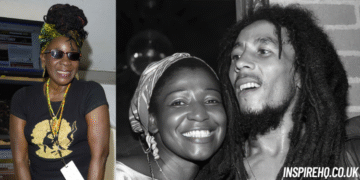Born on November 18, 1962, in San Francisco, Kirk Lee Hammett grew up in the suburban calm of El Sobrante, a place removed from city noise—but never free from creative impulses. His mother, Teofila “Chefela” Oyao, brought rich Filipino traditions into the household, while his father, Dennis Hammett, carried a blend of Irish, German, English, and Scottish roots. This mix of cultures exposed Kirk to diverse worldviews early on, influencing his openness to new music styles and experimentation. Quiet by temperament, Kirk found comfort in drawing and comic books, yet beneath that introversion lay a spark of artistic restlessness. In after-school hours, he’d retreat upstairs to tinker with radio parts or practice sneaky guitar riffs—early signs of the musician he would become. In this article, we will explore young Kirk Hammett—his early life, musical beginnings, personal background, and the path that led him to become a legendary guitarist.
Quick Bio:
| Detail | Info |
|---|---|
| Full Name | Kirk Lee Hammett |
| Born | November 18, 1962 (Age 62 as of 2024) |
| Height | ~5′ 8″ (1.73 m) |
| Early Bands | Exodus (co-founder), Metallica (since ’83) |
| Instruments | Gibson Flying V, ESP KH series guitars |
| Style | Thrash/blues fusion, wah-wah solos, melodic lines |
| Marriages | Rebecca (1987–1990), Lani (m. 1998) |
| Children | Son Angel (b.2006), Son Vincenzo (b.2008) |
| Net Worth | ~ $200 million (2025 estimate) |
| Residences | Sonoma, California; Hawaii |
| Hobbies | Surfing, horror collecting, comic books, gear tinkering |
A Brother’s Record Collection Sparks a Flame
Everything changed when Kirk discovered his brother Rick’s record collection. Nights became sensory adventures: lightning-fast guitar solos, booming drums, ethereal vocals. At 15, Kirk used allowance money and birthday gifts to buy his first guitar. It was a no-frills Montgomery Ward starter, but he treated it like a treasure. Despite the tiny amp—actually a shoebox converted into a speaker box—he learned to cord structures, bending strings, and how to coax emotion from cold metal. When he upgraded to a Fender Stratocaster clone and later the revered 1974 Gibson Flying V, it wasn’t mere equipment—it was freedom. His bedroom became a sanctuary where scales felt like new languages, and his passion grew louder than any amplifier could produce.
Teenage Years: Practice, Gigs, and Peer Jams
High school for Kirk was a phrase defined by persistent energy—not the typical teen distractions, but constant riff rehearsal. At De Anza High, others would go to parties; Kirk would go into private practice with precision and purpose. Lunch breaks found him with his guitar, devouring acapella solos, dissecting Will Hendrix’s phrasing, and copying note-for-note his favorites. Outside of class, he connected with fellow music lovers, including future Primus bassist Les Claypool, honing creative synergy through spontaneous jam sessions. They rotated gear, traded technique ideas, and helped each other grow beyond isolated practice. That immersive teenage world gave Kirk not just technical skill, but mental resilience—learning how to commit to loose setups, unscripted playing, and relentless experimentation.
Founding Exodus: Thrash Roots Born
By 1979, Kirk’s teenage practice sessions had coalesced into a performance-driven mindset. At 16, he co-founded Exodus alongside local musicians Paul Baloff, Gary Holt, and Tom Hunting. The Bay Area was brimming with emerging energy—squeezed between mainstream rock and spiky punk. Exodus delivered thrash in sonic bursts—fast, raw, unfiltered. Their rehearsal space was a barn full of amps and sweat, and their early recordings, including ominous demos like Die By His Hand, captured an urgency that would shape a genre. Kirk, though still young, commanded solos that mirrored that urgency—fast-picked notes laced with bluesy flair. Even then, he didn’t just want speed: he wanted expression and texture. His lessons with Joe Satriani, an early sign of seeking mastery, gave him melodic direction and technical finesse, reinforcing that craft could coexist with chaos.
Audition and Arrival in Metallica
The watershed moment came in April 1983, when Kirk received a call from Metallica, asking him to audition for the vacant lead-guitar spot. At 20, it was an opportunity he’d dreamed of but never expected. He prepared fervently, channeling Exodus energy into metal’s rising giants. The audition—the note-for-note performance of “Seek and Destroy”—showed off both his raw style and disciplined versatility. The band invited him to tour, and within weeks he was in the studio recording Kill ’Em All. To say it was a whirlwind understatement. Kirk had to learn material on the fly, absorb touring life, and balance demanding schedules—with a teenage dream turning into everyday reality. In that chaotic moment, he found his musical home—and set down roots in heavy metal history.
Evolving Sound: Technique and Tone
What began as Hendrix-inspired solos soon evolved into a signature vocabulary. Kirk’s early Metallica work introduced bursts of rapid scales into galloping rhythms; his solos served as narrative arcs rather than flashy showpieces. His bold use of the wah-wah pedal—most memorably on “Enter Sandman”—turned solos into vocal-like cries, expressive and dynamic. Yet he also embraced silence between notes, using space and pacing to heighten drama. From studio overdubs to blazing live performances, Kirk’s tone matured: it became less about speed and more about storytelling. He started threading in classical phrasing, melodic precision, and emotional clarity. Those early choices—honing technique rather than depending on spectacle—strengthened his voice and set him apart from peers.
Stage Image: Leather, Flying V & Long Hair
Between the roaring amps and crowd chants, young Hammett had an unmistakable silhouette: lean, leather-clad, long-haired, Flying V in hand. At about 5’8″, he could have been overshadowed onstage, but his presence felt giant. Live, his focus was inward: eyes closed, fingers fluid, pacing like a wave. His gear setup—Vintage Gibson V, rugged amp stacks, bleacher-ready stereo—matched the sonic aggression but framed it with aesthetic intensity. He wore concert T-shirts and patched denim, not showy costumes. Instead, his posture, guitar stance, and musical confidence filled every gap. Fans didn’t just come for the solos—they came to watch the soul of a writer-in-the-making.
Life Off Stage: Young Surfer & Horror Fan
Away from stage lights, Kirk’s personality revealed a nuanced palette. He became an avid surfer, finding solace in early-morning chilly California swells—far removed from loud stage environments. That solitary communion with the ocean brought clarity and created space to breathe. Simultaneously, he indulged his passion for horror movies, devouring B-movies, vintage props, and chilling soundtracks. He started collecting posters and oddities, weaving them into home decor with a sense of spectacle and respect for narrative. Even as his guitar hero status ascended, he balanced stage adrenaline with quiet creativity. Surfboards hung next to guitars; horror memorabilia filled corners alongside amps—a portrait of a man with both fierce presence and deep curiosity.
Personal Life and Stability
By 1987, Kirk’s success had led to early marriage with Rebecca. That period, filled with touring and success, created strain, and the marriage ended by 1990. Yet it taught him early about balance. In 1998, he married Lani, and they welcomed two sons—Angel in 2006 and Vincenzo in 2008. Even with global fame, Kirk made conscious choices to anchor himself in fatherhood. Tour schedules were coordinated with family time; home was safe from chaos, not another headline. He chose grounded holidays over celebrity parties. Fans admired how he navigated fame without losing personal investment—he didn’t just perform. He fathered. The choice to build a solid family foundation gave him a maturity that tempered rock-star excess and kept his public image aligned with personal values.
Net Worth & Financial Growth
As of 2025, estimates place Kirk’s net worth near $200 million, thanks to decades of album sales, tours, and legacy royalties. Beyond stage-to-stage success with Metallica, he built revenue from gear collaborations (like signature ESP guitars and pedal partnerships), limited-edition merch, even special appearances at horror conventions. He strategically invested in real estate—owning homes in Sonoma and Hawaii—that add value without overshadowing his authentic roots. His financial growth echoes his personal growth: steady, intentional, and reflective of discipline on and off stage.
Social Connections and Media Presence
In recent years, Kirk has maintained a modest social media presence—Instagram boasts about 2.6 million followers, and Facebook another 1.9 million. He’s used platforms not for self-promotion but for sharing glimpses: studio snapshots, family laughs, surf mornings, horror-film finds. His tone over media is calm, understated, almost conversational—aligning with the humility he’s kept since teenage days. Without flashy PR moves, his presence feels genuine, as if fans are getting postcards home, not auction invites. That groundedness in a world of overexposure helps him stay relevant and admirable.
Gear Guru: Building His Sound
From day one, Kirk’s relationship with gear has been scholarly. Starting with homemade modded setups, he grew into a collector and curator of iconic sound machines. His Older Gibson V, ESP KH signature models, and sprawling pedalboard—complete with wah-wah, Tube Screamers, delay loops—come from deliberate selection, not trend-chasing. Whether in studio writing or live touring, he tweaks, listens, and adapts. His tone is precise, his rig is bespoke, and his sound is uniquely tailored to the soul of each song. He’s not just playing guitars—he’s interpreting them.
Solo Project: Portals and Cinematic Expansion
In 2022, Kirk released Portals, a solo EP that surprised and satisfied longtime fans. Built around cinematic soundscapes, balanced guitar work, and emotional storytelling, Portals revealed a different side—a composer spinning atmospheres and textures rather than shredding solos. Inspired by classical motifs and film themes, it was a mature return to his teenage roots—where music was speech, not spectacle. By exploring ambiance and nuance, Kirk showed that early earthiness still finds expression in modern creativity.
Legacy from Youthful Roots
The core of Kirk Hammett’s journey—practicing Hendrix solos in high school, founding Exodus, joining Metallica, balancing life with passion—illustrates a musician defined by devotion and depth. Early talent met persistent rehearsal. Teenage curiosity became stage command. Side-stage surfboards and horror fans became public identity and peace. His youth wasn’t just a precursor to greatness—it was a fertile training ground. Today, his legacy is not just the music played but the integrity sustained: curiosity, humility, and consistency across decades.
Conclusion
Kirk Hammett’s teenage years—rife with obsessive practice, unshakable passion, and quiet discipline—formed the bedrock of an illustrious career that continues to inspire generations of musicians. From bedroom jam sessions in El Sobrante to the roaring arenas of Metallica’s global tours, every phase of his journey reflects an artist in constant evolution. And yet, through it all, he never strayed from his authentic self.
Whether it was his early love of horror films, his quiet humility backstage, or his commitment to refining his craft well into adulthood, Kirk always stayed grounded. He embraced growth without abandoning his roots—allowing each new chapter to build on the last without losing the soul that made his playing unforgettable.
Today, he’s not only respected as one of the greatest lead guitarists in heavy metal history, but also admired as a thoughtful, balanced, and creative individual. His story is a powerful reminder for any aspiring artist: honor where you came from, stay true to your passion, and let your work speak louder than your ego. Because in the end, greatness isn’t just about skill—it’s about authenticity that lasts.
FAQs:
1. What inspired young Kirk Hammett to start playing guitar?
Kirk was first inspired by his brother Rick’s record collection. Hearing bands like Led Zeppelin and Jimi Hendrix lit a spark, and he soon picked up his first guitar with a deep desire to create that same kind of sound.
2. How old was Kirk Hammett when he joined Metallica?
Kirk joined Metallica in 1983 when he was just 20 years old. He had previously played in the band Exodus and brought a fresh energy to Metallica at a critical time.
3. Did Kirk Hammett take formal guitar lessons?
Yes, despite being largely self-taught early on, Kirk eventually took lessons from legendary guitarist Joe Satriani to further refine his skills and technique.
4. What was Kirk Hammett like during his teenage years?
As a teen, Kirk was known for being focused and introverted. He spent most of his free time practicing guitar, watching horror movies, and staying dedicated to improving his craft rather than socializing.
5. What kind of music did young Kirk Hammett listen to?
Kirk was heavily influenced by hard rock and early metal bands. His favorites included UFO, Black Sabbath, and Jimi Hendrix—artists whose styles deeply shaped his playing.
Also Read: Avery Woods Today: Age, Family Life, and Her Social Media Journey










